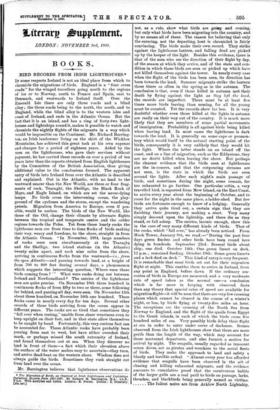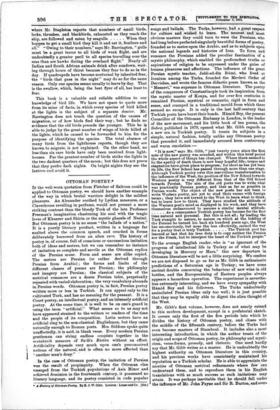BOOKS.
BIRD RECORDS FROM IRISH LIGHTHOUSES.* IN iome respects Ireland is not an ideal place from which to chronicle the migrations of birds. England is a "four cross roads" for the winged travellers going north to the regions of ice or to Norway, south to France and Spain, east to Denmark, and westwards to Ireland itself. Over the Emerald Isle there are only three roads and a blind alley ; the three roads being to the north, the south, and to England, while the blind alley is to the western isles and coast of Ireland, and ends in the Atlantic Ocean. But the fact that it is an island, and has a ring of forty-two light- hoases and lightships round it, makes it possible to watch and chronicle the nightly flights of the migrants in a way which would be impossible on the Continent. Mr. Richard Barring- ton, an Irish landowner living on the skirt of the Wicklow Mountains, has achieved this great task at his own expense and charges for a period of eighteen years. Aided by the men on the lighthouses, who gave their services without payment, he has carried these records on over a period of ten years later than the reports obtained from English lighthouses by the Committee of the British Association, thus giving additional value to the conclusions formed. The apparent entry of birds into Ireland from over the Atlantic is described and explained. Out in the Atlantic, with no land to the westward nearer than the New World, are three or four frag- ments of rock, Tearaght, the Skelligs, the Black Rock of Mayo, and Eagle Island, on which are set the never-dying lamps. No birds cross the intervening ocean, the play- ground of the cyclones and the storm, except the wandering petrels. Migration from America to Europe, even if pos- sible, would be useless. The birds of the New World, like those of the Old, change their climate by alternate flights between the tropical and temperate centre and the colder regions towards the Poles. Yet from these lonely rocks the lighthouse men see from time to time flocks of birds making their way, weary and foredone, to the shore, straight in from the Atlantic Ocean. "In November, 1884, large numbers of rooks were seen simultaneously at the Tearaght and the Skelligs, two island stations (in the Atlantic) twenty miles apart, and each nine miles from the shore, arriving in continuous flocks from the westward—i.e., from, the open Atlantic—and passing towards land, at a height of from 700 to 800 feet during several days, a phenomenon which suggests the interesting question, 'Where were these birds coming from ? " What were rooks doing out between Ireland and Newfoundland? The entries of the lighthouse men are quite precise. On November 10th three hundred in continuous flocks of from fifty to two or three, some following far behind, and passing all day, were seen. On November 15th about three hundred, on November 16th one hundred. These flocks came in nearly every day for ten days. Several other records of these birds arriving from the ocean appear in different years. The rooks are so tired that sometimes they "fall over when resting," unable from sheer weariness even to keep upright on their feet, and in that state allow themselves to be caught by hand. Fortunately, this very curious fact can be accounted for. These Atlantic rooks have probably been passing from east to west, but have either overshot their mark, or perhaps missed the south extremity of Ireland, and found themselves out at sea. When they discover no land in front of them—a fact which their elevation above the surface_ of the water makes easy to ascertain—they turn, and arrive dead-beat on the western shore. Wisdom does not always guide the birds. Sometimes they rush straight out from land over the ocean.
Mr. -Barrington believes that lighthouse observations do
• The ifigration of Birds, as Observed Si Irish Lighthouses and Lightships, Including Reports from 1881-1897. By Richard M. Barrington, MA., LL.B., F.L.B. With Analyses and Index. London B. Porter. Dublin: E. Ponsonby. [25s. net.] no as a rule, show what birds are ,going and coming, but only what birds have been migrating info, the country, and by no means all of these. The reason for believing that only the entering, not the departing, host is chronicled is fairly convincing. The birds make their own record. They strike against the, lighthouse lantern, and falling dead are _picked up by the keeper of the light. Besides this evidence, there is that of the men who see the direction of their light by day, of the season at which they arrive, and of the state and con- dition in which those birds are seen or picked up which have not killed themselves against the tower. In nearly every case when the flight of the birds has been seen, its direction has been towards the land. Summer migrants strike the lantern three times as often in the spring as in the autumn. The conclusion is that, even if those killed in autumn met their death by flying against the light as they left the land, the records are imperfect. There must be at least five times more birds leaving than coming, for all the young must be counted. Yet the records show far less. It is very doubtful whether even those killed at the lights in autumn are really on their way out of the country. It is much more likely that they are members of some partial movements of immigration. Probability is all against birds being killed when leaving land. In most cases the lighthouse is dark towards the land. It is generally on some cape or promon- tory which would itself be the natural starting point of the birds, consequently it is very unlikely that they would hit the light. Where the latter stands on an island off the coast, and on a line of migration, such as the Eddystone, they are no doubt killed when leaving the shore. But perhaps the clearest evidence that the birds seen at lighthouses are the in-comers, and that the outpouring streams are not seen, is the state in which the birds are seen around the lights. After each night's main passage of birds, and sometimes during the night, some remain, far too exhausted to go further. One particular robin, a very travelled bird, is reported from Mew Island, on the East Coast, to arrive every year about the beginning of October, and to roost for the night in the same place, a ladder-shed. But few birds are fortunate enough to know of a lodging. Generally they arrive quite tired out, a certain sign that they are finishing their journey, not making a start. Very many simply descend upon the lightship, and there die as they stand, or fall asleep. The entries, laconic enough, show this in the ease of very many different kinds of birds. That of the rooks, which "fall over," has already been noticed. From Hook Tower, January 8th, we read:—" During the past four days green finches and other birds have been round here dying in hundreds. September 23rd: Several birds about ship ; one died. October 14th: One green linnet on deck, 12 p.m. ; remained feeding. October 19th: Some green linnets and a lark died on deck." This kind of entry is very frequent. It is remarkable that most birds set out for their migration flight at night. This enables them to arrive in Ireland, from any point in England, before dawn. If the ordinary sea- routes of birds in Europe are measured, and a very moderate rate of speed taken as the normal one—a conclusion which is far more in keeping with observed facts than any theory that special rates of speed are available for migration flight—it will be seen that there are very few crossing places which cannot be cleared in the course of a winter's night, or less, by birds flying at twenty-five miles an hour. The exceptions are the crossing of the North Sea from Norway to England, and the flight of the quails from Egypt to the Greek islands, in each of which the birds cross five hundred miles of sea. Very possibly birds delay their flight at sea in order to enter under cover of darkness. Scenes observed from the Irish lighthouses show that there are more perils than the length of the way, which may account for these nocturnal departures, and also furnish a motive for arrival by night. The seagulls, usually regarded as innocent ocean doves, act as pirates and wreckers to the aerial fleets of birds. They make the approach to land and safety a bloody and terrible ordeal. "Almost every year has afforded evidence that seagulls have been observed in the Wit of chasing and killing exhausted migrants, and the evidence amounts to cumulative proof that the carnivorous habits of the larger gulls are a real peril to birds on passage, larks, thrushes, and blackbirds being generally named as victims.
The fullest mates are from Arklow North Lightship,
where Mr. Stapleton reports that niimbers of small birds, larks, thrushes, and blackbirds, exhausted as they reach the
ship, are followed and eaten by seagulls When they happen to get a small bird they kill it and eat it, feathers and all." "Owing to their numbers," says Mr. Barrington, "gulls must be a great terror to all birds of weak flight, and are undoubtedly a greater peril to all species travelling over the seas than are hawks during the overland flight." Nearly all Indian and South African animals drink after sundown, wait- ing through hours of thirst because they fear to do so in the day. If quadrupeds have become nocturnal by inherited fear, the "birds that pass in the night" may do so for the same reason. Only one species seems usually to leave by day. That is the swallow, which, being the best flyer of all, has least to fear.
This book is a valuable and reliable addition to our knowledge of bird life. We have not space to quote more from its mine of facts, in which every species of bird killed at the lights is the subject of a separate dossier. Mr. Barrington does not touch the question of the causes of migration, or of how birds find their way ; but he finds no evidence that the old birds precede the younger. This he is able to judge by the great number of wings of birds killed at the lights, which he caused to be forwarded to him for the purpose of identifying the species. The total absence of many birds from the lighthouse reports, though they are known to migrate, is not explained. On the other hand, no less than six rare birds have only been received from light- houses. Far the greatest number of birds strike the lights in the two darkest quarters of the moon; but this does not prove that they prefer dark nights. On bright nights they see the lantern and avoid it.























































 Previous page
Previous page